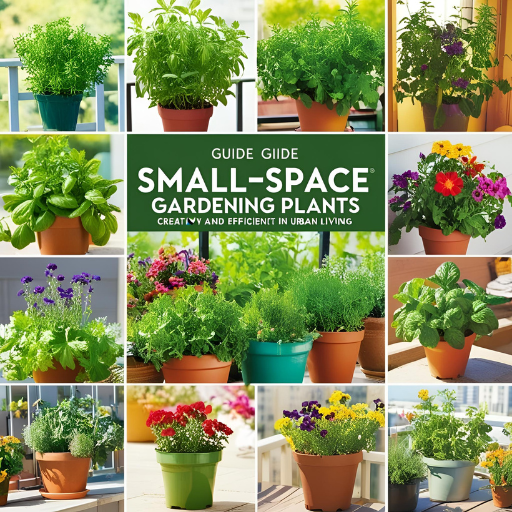Gardening in a small space doesn’t mean you have to limit your creativity or the variety of plants you grow. In fact, small-space gardening can be incredibly efficient, beautiful, and rewarding. Whether you live in an apartment, have a balcony, or just a cozy corner of your backyard, you can grow vibrant, healthy plants that add life and charm to your environment.
In this guide, we’ll explore the best types of plants for small areas, with tips on how to grow them successfully and make the most of your limited space.
Why Small-Space Gardening Is Worth It
Small-space gardening offers a range of benefits that often go overlooked:
-
Easier to Maintain: Less space means less work in terms of weeding, watering, and pruning.
-
Cost-Effective: Fewer plants and tools are needed, making it budget-friendly.
-
Creative Possibilities: You can use vertical space, hanging containers, and other innovative methods.
-
Perfect for Beginners: A smaller garden is less intimidating and easier to manage.
Now, let’s look at the best plants that thrive in compact environments.
Best Edible Plants for Small Gardens
Growing your own herbs and vegetables—even in limited space—can be incredibly satisfying. Here are some top choices:
1. Cherry Tomatoes
-
Why they’re great: Compact, productive, and delicious.
-
Tips: Use a medium to large pot with a trellis or stake for support. Place them in full sun and water regularly.
2. Lettuce and Salad Greens
-
Why they’re great: Quick to grow, can be harvested multiple times.
-
Tips: Choose containers with good drainage. Grow in partial to full sun and keep the soil consistently moist.
3. Radishes
-
Why they’re great: Fast growers that don’t need much space.
-
Tips: Plant in shallow containers. Harvest in 3-4 weeks for a crispy, spicy treat.
4. Herbs (Basil, Parsley, Mint, Thyme, Chives)
-
Why they’re great: Compact, aromatic, and useful in the kitchen.
-
Tips: Grow in individual pots or a shared herb box. Most herbs prefer full sun and well-drained soil.
5. Peppers
-
Why they’re great: Small pepper plants like chili or bell pepper varieties thrive in containers.
-
Tips: Ensure 6+ hours of sun daily. Use a container with a depth of at least 12 inches.
Best Ornamental Plants for Limited Spaces
If you’re looking to enhance your space with beauty and color, these ornamentals are fantastic choices:
1. Marigolds
-
Why they’re great: Bright, easy to care for, and pest-repelling.
-
Tips: Grow in full sun. Deadhead old flowers to encourage new blooms.
2. Petunias
-
Why they’re great: Available in many colors and perfect for hanging baskets.
-
Tips: Water consistently and fertilize every few weeks.
3. Succulents (Echeveria, Sedum, Aloe)
-
Why they’re great: Low-maintenance and stylish.
-
Tips: Use shallow containers with drainage. Water sparingly.
4. Lavender
-
Why they’re great: Beautiful fragrance, attracts pollinators, and drought-tolerant.
-
Tips: Needs full sun and well-drained soil. Great for pots and borders.
5. Geraniums
-
Why they’re great: Hardy, colorful, and ideal for pots or windowsills.
-
Tips: Pinch off faded blooms to encourage growth. Prefer full sun to partial shade.
Clever Gardening Techniques for Small Spaces
You can maximize your space even further by using smart planting methods:
1. Vertical Gardening
Install wall planters, trellises, or hanging shelves to grow upwards instead of outwards. Vining plants like peas, beans, and even strawberries love to climb.
2. Container Gardening
Use pots of various sizes and shapes to fit every nook. Group plants with similar needs for easier care.
3. Hanging Baskets
Perfect for flowers, strawberries, or trailing herbs like oregano and thyme.
4. Tiered Planters
Multi-level planters allow you to grow more plants in less space—great for patios and balconies.
5. Window Boxes
Ideal for herbs and flowers. Mount them outside kitchen or living room windows for easy access and a pretty view.
How to Choose the Right Plants for Your Space
Before buying plants, consider the following:
-
Light Availability: Does your space get full sun, partial shade, or full shade?
-
Water Access: Is it easy to water your plants regularly?
-
Climate and Temperature: Choose plants suitable for your local weather conditions.
-
Maintenance Level: Pick low-maintenance plants if you’re short on time or new to gardening.
It’s also a good idea to plan your layout on paper or digitally before planting.
Common Mistakes to Avoid
Even in small-space gardening, there are pitfalls to watch for:
-
Overcrowding: Too many plants in one pot or bed can lead to poor airflow and disease.
-
Overwatering: Containers dry out faster, but too much water can still cause root rot.
-
Ignoring Plant Labels: Always check how big the plant will get and its needs.
-
Neglecting Pruning: Regularly trim plants to keep them healthy and encourage growth.
Final Thoughts: Less Space, More Beauty
Small-space gardening proves that limitations can inspire creativity. Whether you’re growing juicy cherry tomatoes on a balcony or a bouquet of petunias in a windowsill, every bit of green counts. Focus on smart plant choices, proper care, and maximizing your space with vertical and container options.
With the right approach, your small garden can flourish into a lush, vibrant sanctuary—no backyard required.
